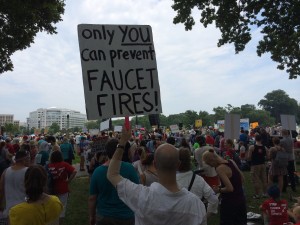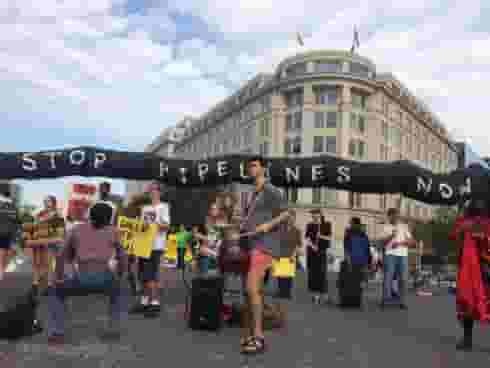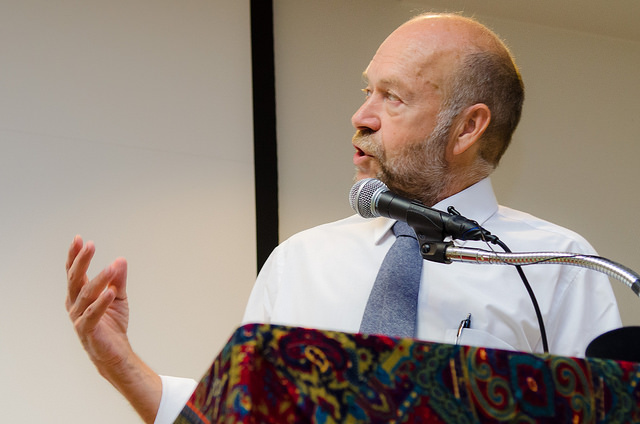On Sunday temperatures ran hot as over a thousand protestors rallied in the nation’s capitol against fracking. The two-day “Stop Gas Exports” actions lasted into Monday and 25 activists were arrested at the Federal Energy Regulatory Commission (FERC) during an act of civil disobedience. Their message: fracking poisons water, land and air and it must be stopped.

The two-day actions were part of an increasing regional mobilization to educate the public about fracking pollution. The protests signal grave concerns by residents over fracking pollution in communities across the country.
Fracking, which is short for hydraulic fracturing, is a shale coal drilling process used to chemically extract methane gas. Methane gas is removed from shale coal deposits and piped to processing stations for export, sometimes hundreds of miles away. Tens of thousands of wells are being built over coal basins in communities across the East and West coasts. But methane gas and fracking chemicals are escaping into the well water of land owners.
During the first wave of protests Sunday afternoon, activists marched to FERC to express opposition to the proposed construction of Dominion Energy’s liquid natural gas (LNG) facility at Cove Point in Lusby Maryland. FERC is reviewing the permit to build the facility and is expected to make a final decision in August. Opponents have claimed that LNG export terminals will accelerate fracking as world demand for methane gas increases.
At the Sunday rally many held colorful hand-made signs while speakers from regions affected by fracking shared experiences of having fracking wells nearby.
Craig Stevens who lives near Dimock, PA, a community in which every resident has been affected by fracking, spoke about tests on his well water. “My water started tasting like metal last year and I had nose bleeds.” He said his water was tested by three universities, including Duke. “They said it was the worst case of private well water they had ever seen.” He said his nose bleeds stopped after he stopped using his water. “They found strontium, uranium and arsenic at ten times the safe levels.”

Laura Norvath, a resident of Loudon County, Viginia, went to the rally with her daughter. “I’m passionate about fracking the more I get to know about it.” She said she has always been an outdoors person and learned about the environment from her mother. “Fracking is one of the worst things to happen to our land in recent history.”
Cheryl Kreiser, a high school teacher, attended the rally because of her concern for her student’s future. “There is only one Mother Earth and if we don’t take care of it we’ll lose everything,” she said. Her hand drawn sign read, ‘Clean Earth Now.’ “There is no reason we can’t use more solar and wind except the oil companies are in the way and these corporations have a big lobby and we have to fight it.”
Later that day the rally attendees marched to FERC in a procession stretching a quarter of a mile. As they arrived, police taped off access to the facility. At FERC they displayed their protest signs while speakers criticized the“rubber stamp” policies of the agency. FERC has approved every permit to build or expand the infrastructure to support the fracking boom.
Anti-fracking supporters created props to accent their message to FERC and energy companies. There were giant hand-painted post cards with written messages of concern to FERC about fracking. A Goliath sized twelve-foot sling-shot with ‘David versus Cove Point’ written on it symbolized Lusby community’s struggle against Dominion and its plan to build the Cove Point gas export terminal. A replica of a gas supertanker named ‘Titanic’ was carried by ten people along the protest march to FERC. Dozens more carried a life-size inflated pipeline on which was written “Stop Cove Point.”
Mike Tidwell, founder and director of Chesapeake Climate Action Network (CCAN) said, “This has been a David and Goliath fight from the beginning and we have a giant sling-shot to prove it.” He motioned towards the prop, “We have been throwing stone after stone to kill Cove Point and we got more stones to throw.”
On Monday, activists returned to FERC during business hours, rallying again. They blocked FERC entrances and 25 were arrested, charged with incommoding (blocking a public sidewalk), and released the same day on $50 bail.
Tidwell thinks the actions are having an effect on public awareness and mobilization. “FERC is just a rubber stamping machine and we intend to change that,” he said.
Horvath plans to return to DC for future events because of plans to set up fracking wells in the Washington Forrest Park reserve, near her home. “It’s just wrong to destroy Mother Nature,” said Horvath as her daughter watched quietly.





